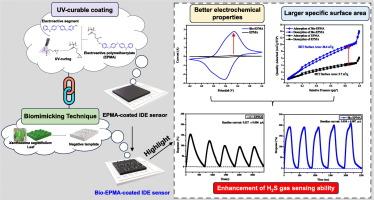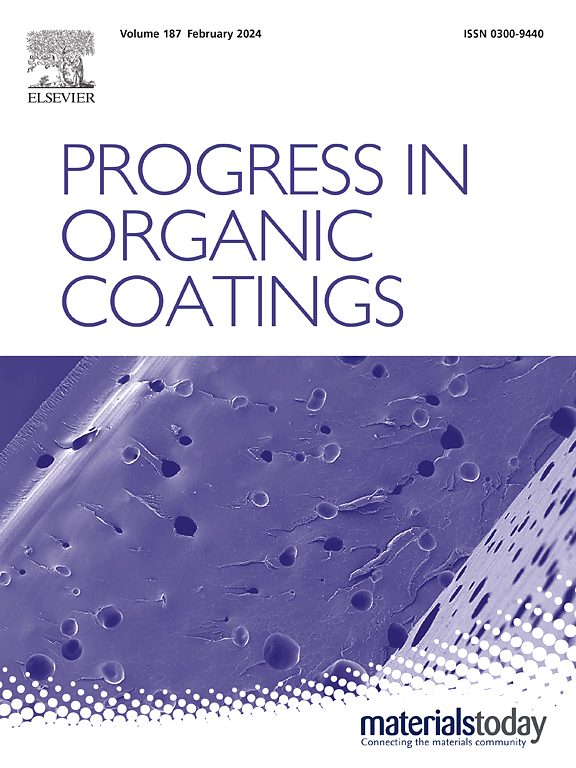来自大自然的蓝图:通过生物仿生技术在紫外固化电活性聚甲基丙烯酸酯薄膜上复制矢车菊叶表面,用于 H2S 气体传感
IF 6.5
2区 材料科学
Q1 CHEMISTRY, APPLIED
引用次数: 0
摘要
本研究介绍了一种利用生物模板电活性聚甲基丙烯酸甲酯(Bio-EPMA)开发 H2S 气体传感器的创新方法,该方法通过将高效、经济的紫外固化技术与生物仿生技术相结合而实现。合成过程中采用的生物仿生模板从天然矢车菊(Xanthosoma sagittifolium)叶片错综复杂的表面结构中汲取灵感,是这一突破性方法的关键。从电活性成分开始,通过氧化偶联反应合成了苯胺四聚物(AT)。与此同时,紫外线固化单体甲基丙烯酸缩水甘油酯(GMA)发生光聚合反应生成聚 GMA,随后与 AT 的氨基发生环氧化物开环反应生成 EPMA。然后通过仿生技术对这种基础聚合物进行精心定制,使其具有仿生物表面形态,最终形成了 Bio-EPMA。对 Bio-EPMA 薄膜的综合分析表明,其具有显著的山丘微结构和纳米皱纹表面形态,BET 表面积从 5.7 m2/g 增加到 20.4 m2/g,可逆掺杂容量增加了 1.15 倍。薄膜制备完成后,用合成的仿生物薄膜涂覆插接电极(IDE)传感器,进行 H2S 气体传感评估。值得注意的是,与非仿生对照组相比,生物-EPMA 薄膜表现出更优越的性能。这种性能的提高归功于 Bio-EPMA 薄膜表面积的增加和生物启发结构,显著提高了 36.2 % 的响应率和重复性,相对标准偏差 (RSD) 从 20.11 % 降至 3.62 %。本文章由计算机程序翻译,如有差异,请以英文原文为准。

Blueprinted from nature: Duplicating the surface of Xanthosoma sagittifolium leaf on UV-curable electroactive polymethacrylate film through biomimicking technique for H2S gas sensing
This research introduces an innovative methodology for developing an H2S gas sensor utilizing bio-templated electroactive polymethacrylate (Bio-EPMA), achieved by integrating efficient and economical UV-curing technology with biomimicking. Drawing inspiration from the intricate surface structure of natural Xanthosoma sagittifolium leaves, the biomimetic template employed during synthesis is pivotal to this groundbreaking approach. Starting from the electroactive component, aniline tetramer (AT) was synthesized via an oxidative coupling reaction. Concurrently, the UV-cured monomer glycidyl methacrylate (GMA) underwent photopolymerization to form poly-GMA, which subsequently underwent an epoxide ring-opening reaction with the amino group of AT to yield EPMA. This base polymer was then meticulously tailored to feature a biomimetic surface morphology through the biomimicking technique, resulting in Bio-EPMA formation. Comprehensive analysis of the Bio-EPMA films showed remarkable hill microstructures and nanowrinkled surface morphology, with an enhancement of BET surface area from 5.7 m2/g to 20.4 m2/g and a 1.15-fold increase in reversible doping capacities. Following film fabrication, interdigitated electrode (IDE) sensors were coated with the synthesized biomimetic films for H2S gas sensing evaluations. Remarkably, the Bio-EPMA film demonstrated superior performance compared to non-biomimetic controls. This amplified performance is attributed to the increased surface area and bio-inspired structure of the Bio-EPMA film, which remarkably resulted in significant enhancements in responsivity by 36.2 % and repeatability with a relative standard deviation (RSD) improvement from 20.11 % to 3.62 %.
求助全文
通过发布文献求助,成功后即可免费获取论文全文。
去求助
来源期刊

Progress in Organic Coatings
工程技术-材料科学:膜
CiteScore
11.40
自引率
15.20%
发文量
577
审稿时长
48 days
期刊介绍:
The aim of this international journal is to analyse and publicise the progress and current state of knowledge in the field of organic coatings and related materials. The Editors and the Editorial Board members will solicit both review and research papers from academic and industrial scientists who are actively engaged in research and development or, in the case of review papers, have extensive experience in the subject to be reviewed. Unsolicited manuscripts will be accepted if they meet the journal''s requirements. The journal publishes papers dealing with such subjects as:
• Chemical, physical and technological properties of organic coatings and related materials
• Problems and methods of preparation, manufacture and application of these materials
• Performance, testing and analysis.
 求助内容:
求助内容: 应助结果提醒方式:
应助结果提醒方式:


